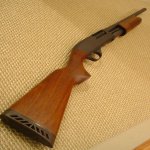I keep hearing about "thin blueing" on internet sites like this one. As someone who has done commercial blueing, I can't say I understand these remarks. There is no such thing as hot caustic "thin" blueing, though I would argue it might apply to cold bluing processes in the colloquial sense. Commercially, a gun is either hot caustic blued or it's not. The process at Illion (like everywhere else) is done to a repeatable ISO 9001 process and "thin" doesn't enter into it.
First the gun is de-greased to clean the metal. There are various ways to do this, but usually a chemical degreasing bath is the last step when this is done in a factory. Remington chemically degreases, as do most manufacturers working at high volumes. The parts are dipped in this bath for around 15 minutes and agitated to remove swarf, oil or grease that could get in the way of the bluing process. Baths can be sodium triphosphate, acetone, etc. Then there is a water rinse and the parts go to the next bath containing the bluing solution.
At a factory, hot bluing is a caustic salt mixture of potassium nitrate and sodium hydroxide. The bath is warmed warmed to a temperature typically from 275 to 310F. the pieces remain in the bluing solution from 15 to 30 minutes, depending on the age of the bath chemicals (they lose effectiveness over time and are tested between batches to set the bluing time for the subsequent batch). After the requisite bath time, they are cold water rinsed and air dripped for a few mintues. The parts are then boiled in water to leech any bluing solution from corners, seams, pores, etc. and to heat the metal to accept oil. This can take up to 45 minutes depending on the mass of the metal parts, as larger parts take longer to come up to temperature.
Lastly, the parts are dunked in water-soluble oil so that even if there is water reside left over, it mixes with the oil into an emulsion and won't rust the guns in storage or transit. This is the typically greasy texture you find on a new gun when you remove it from the box. They don't remove it because it's a good preservative.
Really there is no way for this to be "thin". If the gun turns black, the process was successful. "Thin bluing" is merely the rallying cry of the end user that needs to improve their firearm maintenance regime.









































































